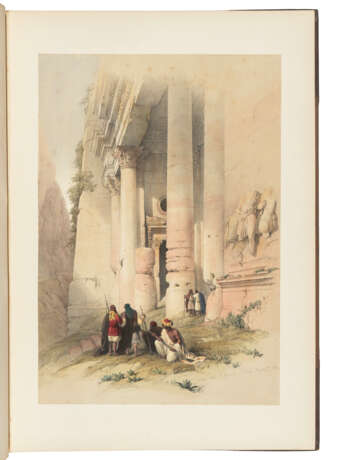ROBERTS, David (1796-1864, artist) and George CROLY (1780-1860)
14.12.2022 10:30UTC +00:00
Classic
Verkauft
119700GBP £ 119 700
| Auctioneer | CHRISTIE'S |
|---|---|
| Veranstaltungsort | Vereinigtes Königreich, London |
| Aufgeld | see on Website% |
Archiv
Die Auktion ist abgeschlossen. Es können keine Gebote mehr abgegeben werden.

ID 870723
Los 183 | ROBERTS, David (1796-1864, artist) and George CROLY (1780-1860)
Schätzwert
£ 90 000 – 120 000
The Holy Land, Syria, Idumea, Arabia, Egypt & Nubia. London: F.G. Moon, 1842-1849.
First edition of the most desirable hand-coloured issue of the ‘apotheosis of the tinted lithograph,’ from the library of Lord Northwick, the first and principal patron of Roberts. John Rushout, second Baron Northwick (1769-1859), collector and art connoisseur, was so impressed with Roberts’ first exhibit at the Royal Academy, a painting of Rouen Cathedral, that he commissioned a replica in 1826. He followed this by further commissioning Roberts' Departure of the Israelites in 1829; both works were instrumental in establishing Roberts' reputation.
Indeed, by 1830, Roberts was firmly established as a topographical artist, and was able to give up his work as assistant scene painter at the Pantheon theatre in Edinburgh. He began to plan his journey to the Middle East in 1838, and in August 1839 departed for Alexandria, spending the remainder of the year in Cairo and visiting the major tombs and sites of Egypt. The following February he journeyed to the Holy Land, making stops in Suez, Mount Sinai, and Petra. He spent time in Gaza before entering Jerusalem and concluded his tour by spending several months becoming familiar with the biblical sites of the Holy Land.
Roberts returned to England at the end of 1839 and submitted his drawings to F.G. Moon in 1840. They were exhibited at the Royal Academy and well received, but Roberts was keen to take advantage of lithography to reach the widest possible audience for his work. The result was one of the most elaborate ventures of 19th-century publishing, providing the most comprehensive series of views of the monuments, landscape, and people of the Middle East. Sold by subscription, it provided Britain with ‘a corpus of visual material that was to influence Western perceptions of Egypt and the Holy Land through the rest of the century’ (Burritt). The complete work was published in 3 states: tinted, with tinted proofs, and coloured and mounted on card (as here); there were also later editions in smaller formats.
Unusually this copy is bound in seven volumes rather than six. The Egypt volumes are bound conventionally in 3 volumes with the plates bound as per Abbey with the exception of the misbound plates 60 and 61. However the Holy Land section is bound in 4 volumes, with only 2 of the 3 pictorial titles, and with the plates in a haphazard order that probably reflects the set being bound up directly from the original parts; the map normally found in vol. I of the Holy Land is bound at the end of the Egypt volumes. Abbey, Travel 272 and 385; Tooley 401. See Amanda Burritt, Visualising Britain’s Holy Land in the Nineteenth Century (2002).
Six volumes bound in seven, folio (609 x 437mm), Egypt conventionally bound in 3 vols, Holy Land in 4 vols. 5 lithographic titles (of 6, lacking title to vol. III of Holy Land) with pictorial vignettes and 241 lithographic plates, the titles and plates finely coloured by hand and mounted on card, 2 engraved maps, lithographic portrait (Holy Land lacking list of subscribers and ‘Description of title page vignettes of Volumes II and III’, title in vol. I of Holy Land torn along part of lower margin, some occasional spotting and cockling). Contemporary brown half morocco gilt, gilt spines, gilt edges, near uniform, but executed by different binders: Holy Land by A. Tarrant, preserving gilt cloth panels from the original parts (split in text block in vol. III just before title, extremities lightly rubbed); Egypt by T. Armstrong over marbled-paper covered boards (extremities lightly rubbed). Provenance: John Rushout, second Baron Northwick (1769-1859; armorial bookplates) – the Eberstadt Collection (sold Sotheby’s 17 November 2015, lot 125).
Special notice
No VAT on hammer price or buyer's premium.
| Herkunftsort: | Nordeuropa, Europa, Vereinigtes Königreich |
|---|---|
| Kategorie des Auktionshauses: | Gedruckte Bücher |
| Herkunftsort: | Nordeuropa, Europa, Vereinigtes Königreich |
|---|---|
| Kategorie des Auktionshauses: | Gedruckte Bücher |
| Adresse der Versteigerung |
CHRISTIE'S 8 King Street, St. James's SW1Y 6QT London Vereinigtes Königreich | |
|---|---|---|
| Vorschau |
| |
| Telefon | +44 (0)20 7839 9060 | |
| Aufgeld | see on Website | |
| Nutzungsbedingungen | Nutzungsbedingungen |











